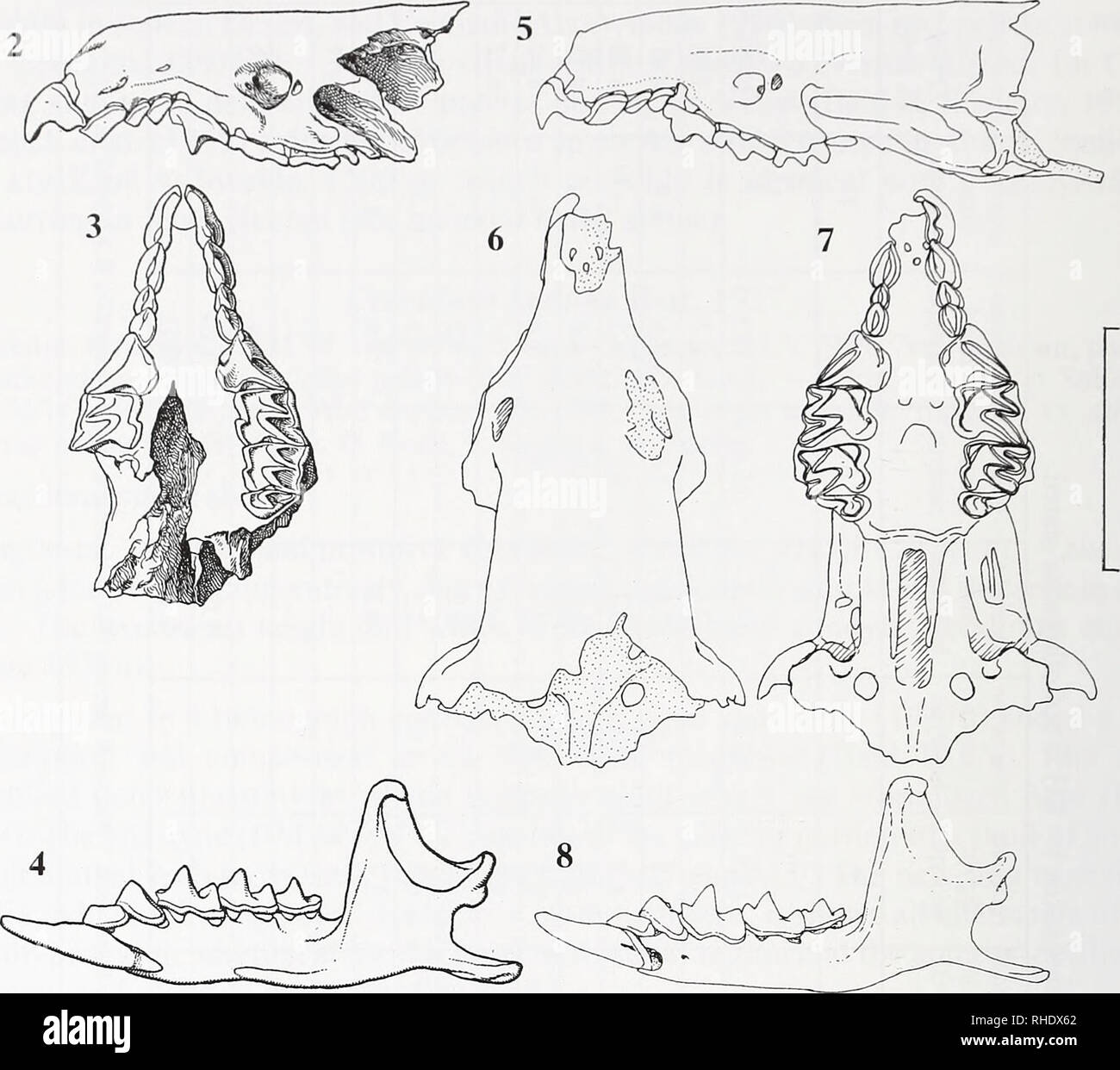Tabun 2 Stock Photos and Images
 Tabun - 2. Stock Photohttps://www.alamy.com/image-license-details/?v=1https://www.alamy.com/tabun-2-image458705595.html
Tabun - 2. Stock Photohttps://www.alamy.com/image-license-details/?v=1https://www.alamy.com/tabun-2-image458705595.htmlRM2HJ7RJK–Tabun - 2.
 . Guide leaflet. o sapiens (modern man) with that of thePithecanthropus-Neanderthal series (e. g, Sinanthropus, Homo soloensis,the Tabun race of Palestine, etc.). The earliest known fossil primates come from the basal Eoceneformations of Western North America. A skull model of one of theMiddle Eocene primates (Fig. 1, 1) shows an unreduced muzzle andrelatively small brain-case. The first apes, with reduced muzzle andenlarged brain-case, date from the Oligocene (Fig. 1, 2). In the longages of the Miocene and Pliocene epochs (the second half of the Ageof Mammals) there was a great branching out Stock Photohttps://www.alamy.com/image-license-details/?v=1https://www.alamy.com/guide-leaflet-o-sapiens-modern-man-with-that-of-thepithecanthropus-neanderthal-series-e-g-sinanthropus-homo-soloensisthe-tabun-race-of-palestine-etc-the-earliest-known-fossil-primates-come-from-the-basal-eoceneformations-of-western-north-america-a-skull-model-of-one-of-themiddle-eocene-primates-fig-1-1-shows-an-unreduced-muzzle-andrelatively-small-brain-case-the-first-apes-with-reduced-muzzle-andenlarged-brain-case-date-from-the-oligocene-fig-1-2-in-the-longages-of-the-miocene-and-pliocene-epochs-the-second-half-of-the-ageof-mammals-there-was-a-great-branching-out-image370784971.html
. Guide leaflet. o sapiens (modern man) with that of thePithecanthropus-Neanderthal series (e. g, Sinanthropus, Homo soloensis,the Tabun race of Palestine, etc.). The earliest known fossil primates come from the basal Eoceneformations of Western North America. A skull model of one of theMiddle Eocene primates (Fig. 1, 1) shows an unreduced muzzle andrelatively small brain-case. The first apes, with reduced muzzle andenlarged brain-case, date from the Oligocene (Fig. 1, 2). In the longages of the Miocene and Pliocene epochs (the second half of the Ageof Mammals) there was a great branching out Stock Photohttps://www.alamy.com/image-license-details/?v=1https://www.alamy.com/guide-leaflet-o-sapiens-modern-man-with-that-of-thepithecanthropus-neanderthal-series-e-g-sinanthropus-homo-soloensisthe-tabun-race-of-palestine-etc-the-earliest-known-fossil-primates-come-from-the-basal-eoceneformations-of-western-north-america-a-skull-model-of-one-of-themiddle-eocene-primates-fig-1-1-shows-an-unreduced-muzzle-andrelatively-small-brain-case-the-first-apes-with-reduced-muzzle-andenlarged-brain-case-date-from-the-oligocene-fig-1-2-in-the-longages-of-the-miocene-and-pliocene-epochs-the-second-half-of-the-ageof-mammals-there-was-a-great-branching-out-image370784971.htmlRM2CF6M0B–. Guide leaflet. o sapiens (modern man) with that of thePithecanthropus-Neanderthal series (e. g, Sinanthropus, Homo soloensis,the Tabun race of Palestine, etc.). The earliest known fossil primates come from the basal Eoceneformations of Western North America. A skull model of one of theMiddle Eocene primates (Fig. 1, 1) shows an unreduced muzzle andrelatively small brain-case. The first apes, with reduced muzzle andenlarged brain-case, date from the Oligocene (Fig. 1, 2). In the longages of the Miocene and Pliocene epochs (the second half of the Ageof Mammals) there was a great branching out
 . Bonner zoologische Beiträge : Herausgeber: Zoologisches Forschungsinstitut und Museum Alexander Koenig, Bonn. Biology; Zoology. 254 R. Hutterer & D. Kock. Figs 2-8. Crocidura katinka Bate, 1937. - 2^, holotype BM Ml5274 from the Pleistocene of Tabun Cave, Israel, cranium in lateral and ventral view and left mandible in labial view (reproduced from Bate 1937b, p. 161); 5-8, SMF 80622, fragment from owl pellets from Syria, cranium in lateral, dorsal and ventral view, and left mandible in labial view. Both figures reduced approximately to the same scale. Scale bar = 5 mm. Levalloiso-Mouster Stock Photohttps://www.alamy.com/image-license-details/?v=1https://www.alamy.com/bonner-zoologische-beitrge-herausgeber-zoologisches-forschungsinstitut-und-museum-alexander-koenig-bonn-biology-zoology-254-r-hutterer-amp-d-kock-figs-2-8-crocidura-katinka-bate-1937-2-holotype-bm-ml5274-from-the-pleistocene-of-tabun-cave-israel-cranium-in-lateral-and-ventral-view-and-left-mandible-in-labial-view-reproduced-from-bate-1937b-p-161-5-8-smf-80622-fragment-from-owl-pellets-from-syria-cranium-in-lateral-dorsal-and-ventral-view-and-left-mandible-in-labial-view-both-figures-reduced-approximately-to-the-same-scale-scale-bar-=-5-mm-levalloiso-mouster-image234489866.html
. Bonner zoologische Beiträge : Herausgeber: Zoologisches Forschungsinstitut und Museum Alexander Koenig, Bonn. Biology; Zoology. 254 R. Hutterer & D. Kock. Figs 2-8. Crocidura katinka Bate, 1937. - 2^, holotype BM Ml5274 from the Pleistocene of Tabun Cave, Israel, cranium in lateral and ventral view and left mandible in labial view (reproduced from Bate 1937b, p. 161); 5-8, SMF 80622, fragment from owl pellets from Syria, cranium in lateral, dorsal and ventral view, and left mandible in labial view. Both figures reduced approximately to the same scale. Scale bar = 5 mm. Levalloiso-Mouster Stock Photohttps://www.alamy.com/image-license-details/?v=1https://www.alamy.com/bonner-zoologische-beitrge-herausgeber-zoologisches-forschungsinstitut-und-museum-alexander-koenig-bonn-biology-zoology-254-r-hutterer-amp-d-kock-figs-2-8-crocidura-katinka-bate-1937-2-holotype-bm-ml5274-from-the-pleistocene-of-tabun-cave-israel-cranium-in-lateral-and-ventral-view-and-left-mandible-in-labial-view-reproduced-from-bate-1937b-p-161-5-8-smf-80622-fragment-from-owl-pellets-from-syria-cranium-in-lateral-dorsal-and-ventral-view-and-left-mandible-in-labial-view-both-figures-reduced-approximately-to-the-same-scale-scale-bar-=-5-mm-levalloiso-mouster-image234489866.htmlRMRHDX62–. Bonner zoologische Beiträge : Herausgeber: Zoologisches Forschungsinstitut und Museum Alexander Koenig, Bonn. Biology; Zoology. 254 R. Hutterer & D. Kock. Figs 2-8. Crocidura katinka Bate, 1937. - 2^, holotype BM Ml5274 from the Pleistocene of Tabun Cave, Israel, cranium in lateral and ventral view and left mandible in labial view (reproduced from Bate 1937b, p. 161); 5-8, SMF 80622, fragment from owl pellets from Syria, cranium in lateral, dorsal and ventral view, and left mandible in labial view. Both figures reduced approximately to the same scale. Scale bar = 5 mm. Levalloiso-Mouster